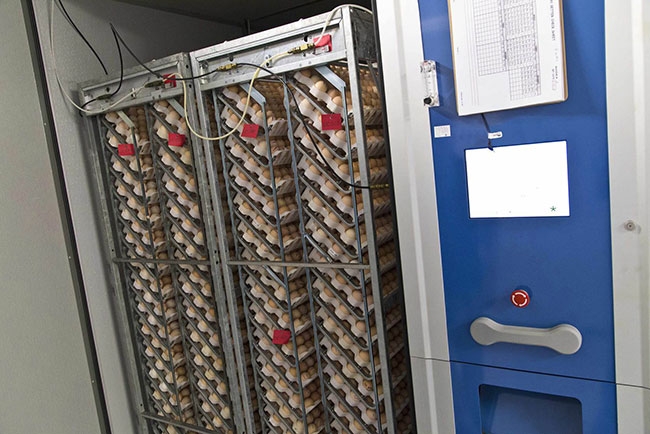
Aviagen demonstrates commitment to Canadian poultry industry with new hatchery
By Madeleine Baerg
Features Business & Policy Company News annex Canada Company News Livestock Production Poultry Production Production Success in Agriculture United States Most of the chicks hatched at the Watertown facility will be destined for Canadian broiler breeding barns. Photo: Aviagen
Most of the chicks hatched at the Watertown facility will be destined for Canadian broiler breeding barns. Photo: AviagenThe opening of a new broiler breeding stock hatchery by industry powerhouse Aviagen in January in northern New York State is good news for the Canadian poultry industry.
Located just a 30-minute drive from the Canadian border and fairly close to JFK International Airport, the new facility will minimize transport time to eastern Canadian broiler chicken breeder barns.
“The Watertown hatchery isn’t located where we’d put hatchery to supply most of our customers in the U.S.,” says Frank Dougherty, Aviagen’s vice-president of sales and technical service for North America. “It’s a commitment from us to support the industry in Eastern Canada. Since our priority is to get the chicks to farms as quick as we can, close proximity via road or air will help safeguard the chicks’ health, safety and welfare.”
Approximately two-thirds of the chicks hatched at the Watertown facility will be destined for Canadian broiler breeding barns. Giuseppe Caminiti, executive director of the Canadian Hatching Egg Producers, applauds the new facility’s Canada-oriented location.
“From our perspective, it is very beneficial that the new Watertown hatchery is located so close to the Ontario border,” Caminiti says. “The shorter the transport time, the better.”
Broiler breeder farmers are unlikely to notice significant changes to service or quality.
“Our priority is to grow steadily,” says Jason Mack, Aviagen’s vice-president of operations for North America. “We typically operate at 80 to 90 per cent capacity in any of our hatcheries. As we begin to reach full capacity in other facilities, we bring another on stream. The opening of this facility won’t cause significant ripples within the industry. That’s the opposite of what we want.”
Currently, Aviagen supplies approximately 75 per cent of all Canadian broiler breeding stock. Virtually all of these birds are Ross brand genetics, which is celebrating its 61st year of production this year.
Each year, Aviagen invests 10 per cent of all revenue into research and development to further improve its stock’s performance.
“The new location allows us to better service and supply our Canadian customers. They’ll still be able to expect the same top quality breeding stock as from any of our other facilities, just now in their backyard. At the end of the day, it’s all about the product that customers are ultimately producing. Our buyers choose us not just for location, but also for feed conversion, growth rate and livability,” Mack says.
While the new facility’s opening is due in part to strong market capture, the company is also benefitting from growing consumer demand for chicken.
Poultry sales continue to increase due to changing socioeconomic conditions globally, as well as positive domestic drivers like low-carb diet trends and changing protein preferences among consumers.
Annual per capita consumption of chicken in Canada has grown steadily from 16.88 kilograms (kg) in 1980 to 31.86 kg in 2015. Meanwhile, beef and pork consumption during this same period has dropped by approximately one-third each, from 38.81 kg and 32.16 kg per capita respectively in 1980 to 24.40 kg and 22.16 kg respectively in 2015.
The Canadian Hatching Egg Producers group is anticipating 1,196 million kg of chicken to be produced in 2017, an increase of 4.2 per cent over 2016.
“We continue to see strong demand in both Canada and the U.S., with poultry now the number one source of protein in both countries,” Dougherty says. “The market fundamentals in Canada are much simpler than they are in the U.S. In Canada, there’s been a consistent two to three per cent increase in quota allocation. In the U.S., we’ve had tremendous business growth, some because of increased consumer demand per capita but most at the expense of our competition.”
The Watertown facility is Aviagen’s seventh commercial breeding stock hatchery in the U.S.
The facility has a capacity of 135,000 chicks per week, totalling about seven million chicks per year.
In addition, Aviagen expanded its Sallisaw, Okla., facility and is currently developing another project in Georgia, though ground has not yet been broken on this location.
Broiler breeding stock form the parent generation for Canada’s broiler hatching egg producers. According to Statistics Canada, there were approximately 244 broiler hatching egg producers in Canada in 2015, 46 per cent of which were located in Ontario or Quebec.
In the same year, these farms produced 707.7 million broiler stock eggs for Canadian hatcheries. The total farm cash receipts Canada’s hatching egg producers earned in 2015 increased to $289.1 million, up 1.5 per cent from the previous year.
Print this page